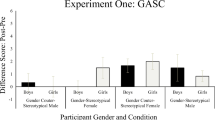Abstract
Previous studies reveal the reinforcement of gender stereotypes by picture books children read during the formative years. In these books, boys tend to be portrayed as active leaders, and girls as passive followers. Women and girls are under-represented. Men often exhibit career skills, and women perform traditional tasks in the home. Even when careers are nontraditional, personality characteristics and other qualities and behaviors are often stereotypical. Previous researchers emphasized the narrowly defined roles of women and children in picture books. In this study, we focused on the representation of mothers and fathers, and examined whether men are stereotyped as relatively absent or inept parents. A content analysis of the gender roles exhibited in 200 prominent children’s picture books demonstrated that fathers are largely under-represented, and, when they do appear, they are withdrawn and ineffectual parents. Further research could establish whether seriously deficient models of fatherhood in children’s literature affect the incidence of present, caring fathers in society.
Similar content being viewed by others
References
Allen, A. M., Allen, D. N., & Sigler, G. (1993). Changes in sex-role stereotyping in Caldecott Medal Award picture books 1938–1988. Journal of Research in Childhood Education, 7, 67–73.
Bird, C. E. (1997). Gender differences in the social and economic burdens of parenting and psychological distress. Journal of Marriage and the Family, 59, 809–823.
Bird, C. E. (1999). Gender, household labor, and psychological distress: The impact of the amount and division of housework. Journal of Health and Social Behavior, 40, 32–34.
Blankenhorn, D. (1995). Fatherless America. New York: HarperCollins.
Bond, J. T., Thompson, C., Galinsky, E., & Prottas, D. (2003). The national study of the changing workforce. New York: Families and Work Institute.
Children’s Book Council. (2002). Industry sales survey for the years 1999–2001. New York: Children’s Book Council.
Collins, L. J., Ingoldsby, B. B., & Dellmann, M. M. (1984). Sex-role stereotyping in children’s literature: A change from the past. Childhood Education, 60, 278–285.
Diekman, A. B., & Murnen, S. K. (2004). Learning to be little women and little men: The inequitable gender equality of nonsexist children’s literature. Sex Roles, 50, 373–385.
Dougherty, W. H., & Engel, R. E. (1987). An 80’s look for sex equality in Caldecott winners and honor books. Reading Teacher, 40, 394–398.
Downs, B. (October). Fertility of American women: June 2002. [Current Population Reports.] Washington, DC: U.S. Census Bureau.
Eastman, P. D. (1960). Are you my mother? New York: Random House.
Fischer, A. H., & MosQuera, P. M. R. (2001). What concerns men? Women or other men? Psychology, Evolution, and Gender, 3, 5–25.
Fox, M. (1993). Men who weep, boys who dance: The gender agenda between the lines in children’s literature. Language Arts, 70, 84–88.
Hamilton, M. C. (2001). Sex-related difference research: Personality. Encyclopedia of women and gender (Vol. 2, pp. 973–981). San Diego: Academic Press.
Hamilton, M., Anderson, D. A., Broaddus, M., & Young, K. (2005). Sex stereotyping and under-representation of female characters in 200 popular children’s picture books: A 21st century update. Manuscript in preparation.
Heintz, K. E. (1987). An examination of sex and occupational-role presentations of female characters in children’s picture books. Women’s Studies in Communication, 11, 67–78.
Johns, M. L. (1981). The influence of picture books on sex role attitudes and knowledge of sex role stereotypes in kindergarten children. Dissertation Abstracts International, 42(04B), 1634.
Kolbe, R., & LaVoie, J. C. (1981). Sex role stereotyping in preschool children’s picture books. Social Psychology Quarterly, 44, 369–374.
Kortenhaus, C. M., & Demarest, J. (1993). Gender role stereotyping in children’s literature: An update. Sex Roles, 28, 219–232.
Lamb, M. (1986). The father’s role: Applied perspectives. New York: Wiley.
McDonald, S. M. (1998). Sex bias in the representation of male and female characters in children’s picture books. Journal of Genetic Psychology, 150, 389–401.
Narahara, M. (1998). Gender stereotypes in children’s picture books. (ERIC Document Reproduction Service No. ED419248.) East Lansing, MI: National Center for Research on Teacher Learning.
Nilsen, A. P. (1978). Five factors contributing to the unequal treatment of females in children’s picture books. Top of the News, 34, 255–259.
Pleck, J. (1981). The myth of masculinity. Cambridge, MA: MIT Press.
Purcell, P., & Stewart, L. (1990). Dick and Jane in 1989. Sex Roles, 22, 177–185.
Raag, T., & Rackliff, C. L. (1998). Preschoolers’ awareness of social expectations of gender: Relationships to toy choices. Sex Roles, 38, 685–700.
Ross, C. E., & Mirowsky, J. (1988). Child care and emotional adjustment to wives’ employment. Journal of Health and Social Behavior, 29, 127–138.
Silverstein, L. B. (1996). Fathering is a feminist issue. Psychology of Women Quarterly, 20, 3–37.
Speed, T. (2000). Brave potatoes. New York: Putnam.
Trepanier-Street, M. L., & Romatowski, J. S. (1999). The influence of children’s literature on gender role perceptions: A reexamination. Early Childhood Education Journal, 26, 155–159.
Turner-Bowker, D. M. (1996). Gender stereotyped descriptors in children’s picture books: Does “Curious Jane” exist in the literature?. Sex Roles, 35, 461–488.
U. S. Census Bureau. (2003, June 2). Facts for features: Fathers Day: June 15. CB03-FF.08. Retrieved August 26, 2003 from http://www.census.gov/Press-Release/www/2003/cb03-ff08.html
Weitzman, L., Eiffer, D., Hokada, E., & Ross, C. (1972). Sex-role socialization in picture books for preschool children. American Journal of Sociology, 77, 1125–1150.
Williams, J., Vernon, J., Williams, M., & Malecha, K. (1987). Sex role socialization in picture books: An update. Social Science Quarterly, 68, 148–156.
Author information
Authors and Affiliations
Corresponding author
Rights and permissions
About this article
Cite this article
Anderson, D.A., Hamilton, M. Gender Role Stereotyping of Parents in Children’s Picture Books: The Invisible Father. Sex Roles 52, 145–151 (2005). https://doi.org/10.1007/s11199-005-1290-8
Issue Date:
DOI: https://doi.org/10.1007/s11199-005-1290-8



